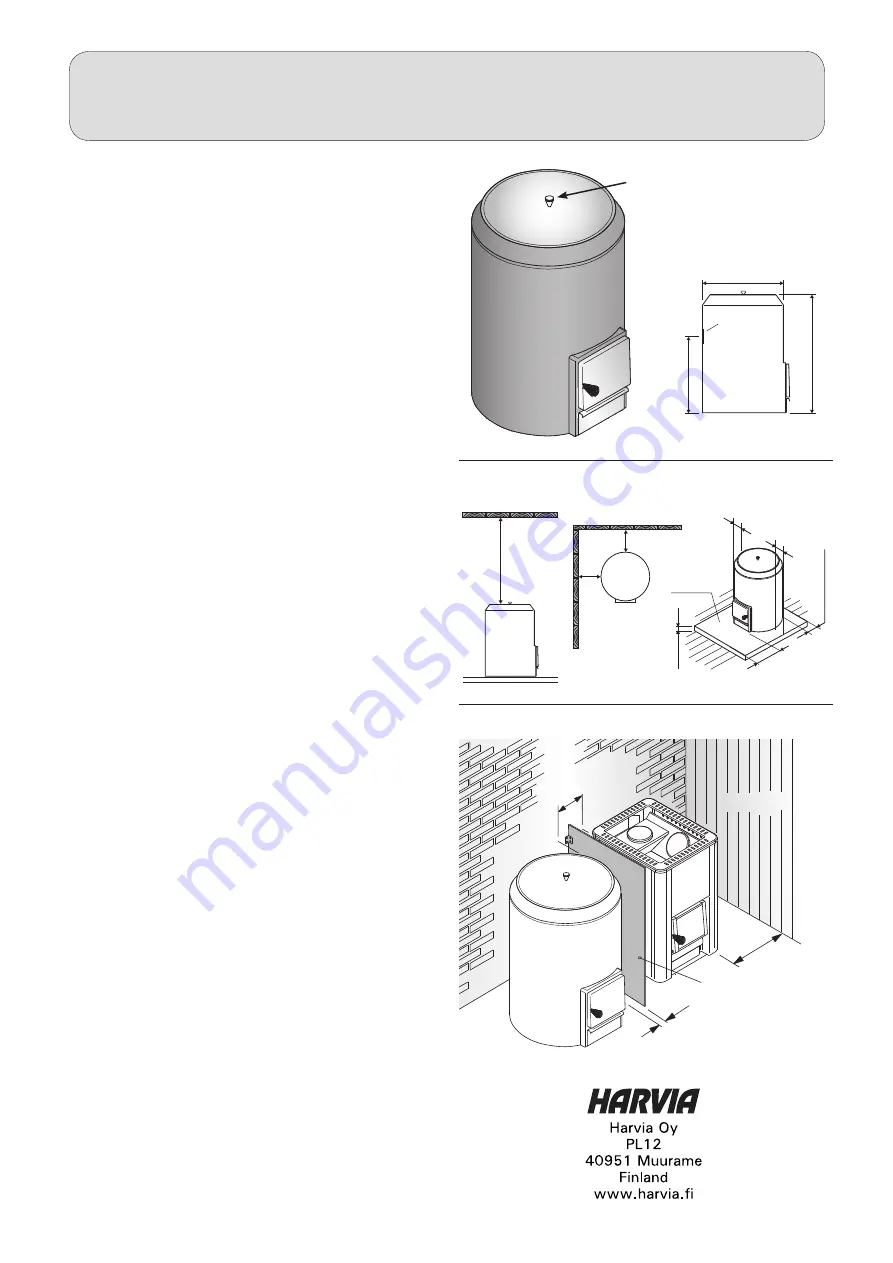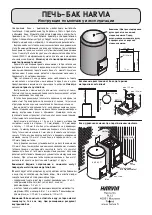
25022010
HARVIA CAULDRON
Instructions for Installation and Use
The flue connections of cauldrons must be made with
great care. The connecting pipe must fit tightly against the
pipe lining. The diameter of the flue outlet should be ca.
10–15 mm bigger than that of the connecting pipe. The
space between the pipe and the flue outlet must be tightly
sealed, for example, with mineral wool.
The inner cauldron is made of high-quality stainless
steel. Note! Foreign substances in water or transfered in
the cauldron by e.g. a grinding machine, such as iron, may
cause rust spots. These can easily be removed using a fine
(400) water sandpaper or emery paper on the surface. Do
not use steel wool for cleaning.
When the inner cauldron is filled with cold water, some of
the water may condense on the cauldron’s outer surface,
which may arouse suspicion of a possible leak in the
cauldron. This is, however, a natural phenomenon and will
disappear as the water warms up.
Rather than fill the cauldron to the brim, leave it a few
centimetres short of full to avoid overboiling. The cauldron
must never be heated when empty.
The inner cauldron can be removed for cleaning and
chimney sweeping. If the outer surface of the inner
cauldron is covered with a thick layer of soot, water will
heat up more slowly and the consumption of firewood
will increase.
Use only good quality wood (no resinous wood) in the
furnace. Burning should take place slowly. The fire can
be made very small by changing the position of the ash
box.
Cauldrons do not draw air as well as wood-burning
stoves due to the narrow and initially cold smoke duct
between inner cauldron and lining. Close the damper (sold
as an accessory) when the fire has finished burning to keep
the water warm longer.
The safety distance of inflammable materials is 150 mm
sideways and backwards, 500 mm to front and 1000 mm
up towards the ceiling. If the cauldron is placed on a
wooden base, a concrete slab at least 60 mm thick must be
cast between the base and the cauldron, or a corresponding
sheath must be put in place. The slab must extend at least
100 mm sideways past the cauldron walls and 400 mm
forward from the chamber door.
If a wood-burning stove is placed closer than 250 mm
from the cauldron, the stove and cauldron must be separated
by a non-flammable protective sheath that prevents the
stove’s heat from damaging the surface of the cauldron.
The purpose of the sheath is to protect the cauldron from
direct heat radiation from the stove. When equipped with
a sheath, the stove and cauldron can be located as close
ad 60 mm from each another.
NOTE! Impurities and chemicals in the water may
damage the metal parts of the cauldron.
The water used in the cauldron should meet the requirements
of clean household water. The following factors have an
essential influence on water quality:
humus concentration (colour, taste, precipitation);
recommended concentration is less than 12 mg/litre.
iron concentration (colour, odour, taste,
precipitation); recommended concentration is less
than 0.2 mg/litre.
hardness; the most important substances are
manganese (Mn) and calcium (Ca); recommended
content of manganese is less than 0.05 mg/litre, and
calcium less than 100 mg/litre.
NOTE! Do not allow water to freeze in the cauldron as
expanding ice may break the inner cauldron.
•
•
•
Note! The knob of the lid is
placed on the underside of
the lid for transportation.
Before use, remove the knob
and attach it on the upper
side of the lid.
Cauldron and wood-burning stove side-by-side
CAULDRON AND WOOD-BURNING STOVE SIDE-BY-SIDE
CONCRETE
WOOD PANEL
BRICK
NON-FLAMMABLE
PROTECTIVE PLATE
CAULDRON 80 L
min. 60 mm
min. 30 mm
min.
500 mm
The safety distance of inflammable materials
CONCRETE
min.
400
mm
530 mm
740 mm
590 mm
Ø145 mm
75 kg
min. 150
mm
min. 100
mm
min. 100
mm
min.
60
mm
min.
100
mm
m
in.
150
mm
m
in.
1000
mm




















